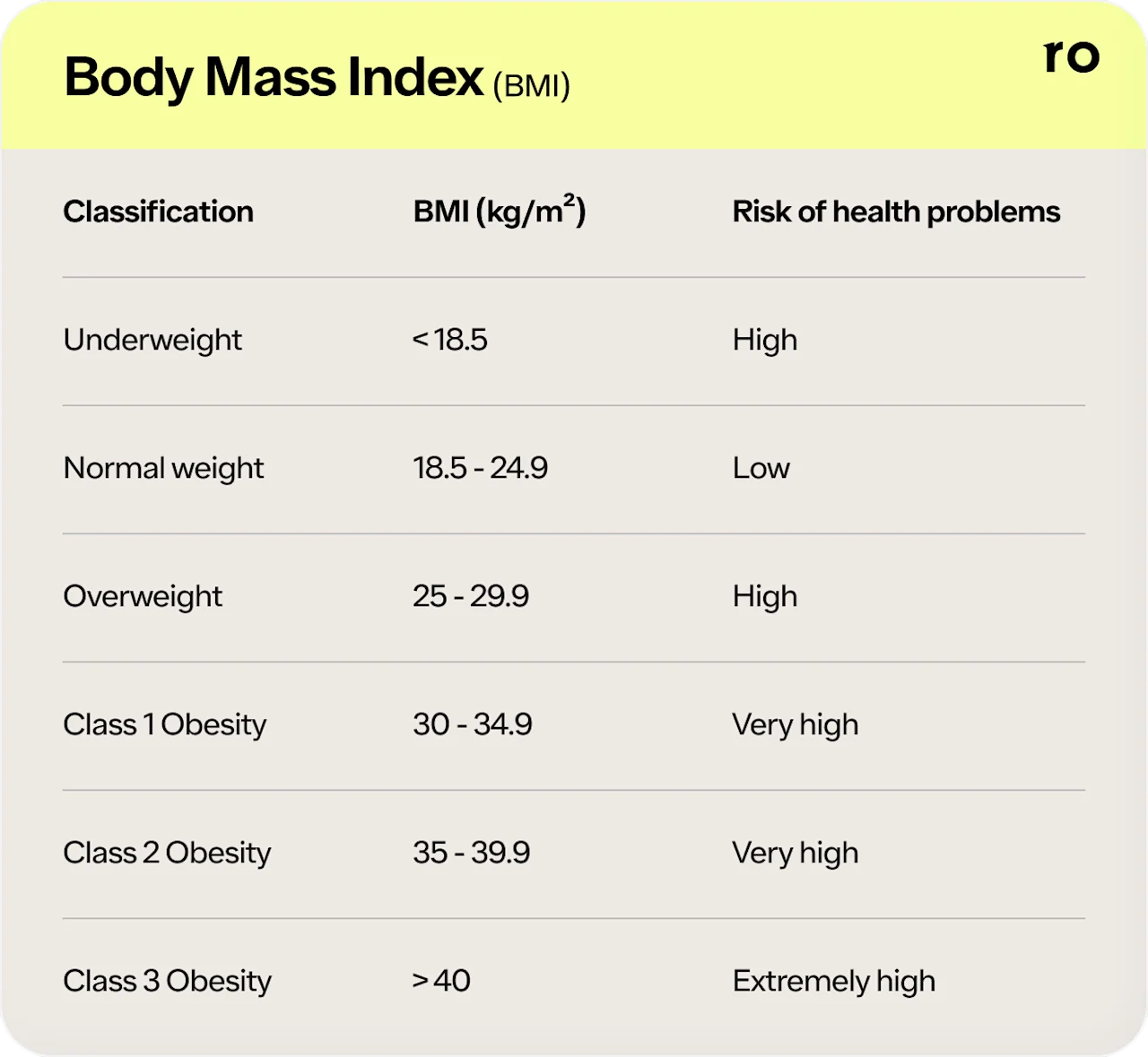Here's what we'll cover
Here's what we'll cover
Here's what we'll cover
If you’re trying to get pregnant, you’re likely wondering what healthy habits will help with conception. Exercising and maintaining a healthy weight may help increase your chances of becoming pregnant. Still, some types of exercise may negatively affect fertility.
Let’s take a look at how weight and exercise may impact fertility and conception.
Weight and fertility
Your overall health and well-being are essential when trying to conceive. Healthy habits, including diet and exercise, support your overall health, which includes your weight and fertility.
Having too much or too little body fat may negatively impact your fertility and body’s ability to maintain a healthy pregnancy.
Healthcare professionals often use body mass index (BMI) categories to determine whether someone has a healthy weight. Body mass index compares height to total body mass, which includes fat, muscles, and other lean tissues in the body.
Here are the BMI categories (Weir, 2021):

Overweight and obesity
Research suggests that women with overweight or obesity are more likely to experience fertility problems, such as (Dag, 2015):
Lower conception rates
Increased risk of miscarriage
Higher risk of infertility
Underweight
Similar to excess weight, having a low body weight may also lead to infertility. Having too little body fat can cause (Boutari, 2020):
Anovulation, a condition where the body stops ovulating (releasing eggs)
Dysfunction or interruption of the menstrual cycle
People with eating disorders, like anorexia or bulimia, or those who over-exercise may experience problems with fertility (Boutari, 2020).
Can weight loss increase fertility?
Weight loss may help people with overweight or obesity increase their fertility and chances of a healthy pregnancy (Dag, 2015).
But for people at a healthy weight or with underweight, trying to lose weight is not a good idea—it likely won’t improve fertility, may even lead to fertility problems, and can lead to all sorts of other health issues. Talk with your healthcare provider about what a healthy weight looks like for you and tips for maintaining that weight.
Many people find it helpful to focus on healthy behaviors rather than their weight because increasing physical activity and eating a nutritious diet helps support their goals without creating any unhealthy behaviors.
Does exercise help fertility?
Overall, studies suggest that exercising consistently can help support your health and fertility. However, the type and intensity of exercise will affect whether the workout improves or impairs fertility.
Here’s what studies say about exercise, weight, and fertility:
Physical activity may improve the chances of becoming pregnant and having a healthy birth in women with reproductive health problems, such as polycystic ovary syndrome (PCOS) (Mena, 2019).
A 2020 cohort study found that infertility was more common in women with obesity and less common in women who exercise regularly (Mena, 2020).
A 2017 systematic review found reduced-calorie diets and increased physical activity resulted in weight loss and improved ovulation in people with overweight and obesity (Best, 2017).
A 2014 randomized control trial found that a healthy diet, exercise, and behaviors improved pregnancy and live birth rates in women with obesity (Sim, 2014).
Women who were physically active before undergoing in vitro fertilization (IVF) treatments are more likely to conceive and carry to live births than women living a sedentary lifestyle before treatments (Rao, 2018).
Extremely heavy exercising (intense workout > 60 minutes a day) increases the risk of anovulation and fertility problems (Hakimi, 2017).
Whether you’re trying to conceive naturally or undergoing fertility treatments, regular physical activity appears to increase fertility and chances of conceiving, as long as it’s not overly intense.
Exercises to increase fertility
When you’re trying to conceive, consider the types of workouts you’re doing. Moderate exercise routines appear to be more beneficial than vigorous workouts for improving fertility. Intense workouts could still be done a few times a week, but try to avoid doing these types of workouts daily:
High-intensity interval training
CrossFit
Powerlifting
Sprinting and long-distance running
Instead of vigorous exercise, aim for more moderate-intensity physical activity. When you’re doing moderate-intensity exercises, it should feel somewhat hard. Moderate exercises increase your heart rate and will feel like you’re breathing harder than usual, but you shouldn’t feel out of breath like during vigorous exercise.
Here are some low- to moderate-intensity exercises that may help fertility:
Jogging
Cycling
Dancing
Water aerobics
Pushing a lawnmower or raking leaves
Hiking
Over-exercising and fertility
While overall, regular exercise and eating a healthy diet will help improve fertility, it’s important to know that there can be too much of a good thing.
Over-exercising and extreme dieting can lead to fertility problems, loss of period, and inconsistent ovulation (Hakimi, 2017).
If you notice irregularities in your periods or they are completely absent, consider pulling back on the intensity of your workouts and seek help from your healthcare provider. Research suggests that increasing vigorous activity increases the amount of time it takes to become pregnant for many women (Wise, 2012).
Talk with your healthcare provider if you’re having problems with your menstrual cycle or fertility for support and medical advice.
DISCLAIMER
If you have any medical questions or concerns, please talk to your healthcare provider. The articles on Health Guide are underpinned by peer-reviewed research and information drawn from medical societies and governmental agencies. However, they are not a substitute for professional medical advice, diagnosis, or treatment.
References
Best, D., Avenell, A., & Bhattacharya, S. (2017). How effective are weight-loss interventions for improving fertility in women and men who are overweight or obese? A systematic review and meta-analysis of the evidence. Human Reproduction Update , 23 (6), 681–705. doi: 10.1093/humupd/dmx027. Retrieved from https://pubmed.ncbi.nlm.nih.gov/28961722/
Boutari, C., Pappas, P. D., Mintziori, G., Nigdelis, M. P., Athanasiadis, L., Goulis, D. G., & Mantzoros, C. S. (2020). The effect of underweight on female and male reproduction. Metabolism: clinical and experimental , 107 , 154229. doi: 10.1016/j.metabol.2020.154229. Retrieved from https://pubmed.ncbi.nlm.nih.gov/32289345/
Dağ, Z. Ö., & Dilbaz, B. (2015). Impact of obesity on infertility in women. Journal of the Turkish German Gynecological Association , 16 (2), 111–117. doi: 10.5152/jtgga.2015.15232. Retrieved from https://www.ncbi.nlm.nih.gov/pmc/articles/PMC4456969/
Hakimi, O., & Cameron, L. C. (2017). Effect of exercise on ovulation: a systematic review. Sports Medicine , 47 (8), 1555–1567. doi: 10.1007/s40279-016-0669-8. Retrieved from https://pubmed.ncbi.nlm.nih.gov/28035585/
Mena, G. P., Mielke, G. I., & Brown, W. J. (2019). The effect of physical activity on reproductive health outcomes in young women: a systematic review and meta-analysis. Human Reproduction Update , 25 (5), 541–563. doi: 10.1093/humupd/dmz013. Retrieved from https://pubmed.ncbi.nlm.nih.gov/31304974/
Mena, G. P., Mielke, G. I., & Brown, W. J. (2020). Do physical activity, sitting time and body mass index affect fertility over a 15-year period in women? Data from a large population-based cohort study. Human Reproduction , 35 (3), 676–683. doi: 10.1093/humrep/dez300. Retrieved from https://pubmed.ncbi.nlm.nih.gov/32175580/
Rao, M., Zeng, Z., & Tang, L. (2018). Maternal physical activity before IVF/ICSI cycles improves clinical pregnancy rate and live birth rate: a systematic review and meta-analysis. Reproductive Biology and Endocrinology , 16 (1), 11. doi: 10.1186/s12958-018-0328-z. Retrieved from https://www.ncbi.nlm.nih.gov/pmc/articles/PMC5803901/
Sim, K. A., Dezarnaulds, G. M., Denyer, G. S., Skilton, M. R., & Caterson, I. D. (2014). Weight loss improves reproductive outcomes in obese women undergoing fertility treatment: a randomized controlled trial. Clinical Obesity , 4 (2), 61–68. doi: 10.1111/cob.12048. Retrieved from https://pubmed.ncbi.nlm.nih.gov/25826729/
Weir C. B., Jan A. (2021). BMI classification percentile and cut off points. [Updated 2021 June 29]. In: StatPearls [Internet]. Retrieved on Dec. 23, 2021 from https://www.ncbi.nlm.nih.gov/books/NBK541070/
Wise, L. A., Rothman, K. J., Mikkelsen, E. M., Sørensen, H. T., Riis, A. H., & Hatch, E. E. (2012). A prospective cohort study of physical activity and time to pregnancy. Fertility and Sterility , 97 (5), 1136–42.e424. doi: 10.1016/j.fertnstert.2012.02.025. Retrieved from https://www.ncbi.nlm.nih.gov/pmc/articles/PMC3340509/












